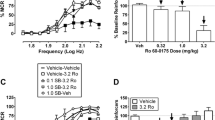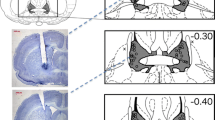Abstract
The effects of serotonin receptor antagonists with differential selectivity for the various classes of 5HT receptors (5HT1, 5HT2 and 5HT3) were tested for their effects on the response to aversive brain stimulation. Electrical stimulation was administered to the dorsal part of the periaqueductal gray matter (PAG), one of the main cerebral structures subserving negative reinforcement. Stimulation frequency thresholds for escape responses were recorded before and following administration of the compounds. Ketanserin (0.32–32 mg/kg IP), trazodone (1.0–22 mg/kg), pirenperone (0.032–1.0 mg/kg) and spiperone (0.1–0.2 mg/kg) dose-dependently increased stimulation frequency thresholds necessary to induce escape responses. Opposite effects were observed with mianserin (0.01–32 mg/kg) and metergoline (0.032–10 mg/kg) which decreased threshold for escape. ICS 205-930 (0.01–10 mg/kg), MDL 72222 (0.1 22 mg/kg) and GR 38032 F (0.1–10 mg/kg) did not affect the stimulation frequency threshold for escape. Prazosin (0.1–2.2 mg/kg) did not specifically affect aversive brain stimulation. Haloperidol (0.02–1.0 mg/kg) increased the frequency threshold for escape responses but with some motoric side effects. These data show that the various types of 5HT receptors differentially contribute to the control of central aversive systems in rats. It is suggested that blockade of 5HT2 receptors suppresses the central aversive system, whereas blockade of some 5HT1 receptors enhances aversion and overcomes the 5HT2-mediated suppression. Blockade of 5HT3 receptors has no effects. Dopamine receptor blockade further contributes to the suppression of the central aversive system. The relevance of these findings to some pathophysiological mechanisms of anxiety and depressive disorders is discussed.
Similar content being viewed by others
References
Ansseau M, Doumont A, Thiry D (1983) Pilot study of a specific serotonergic antagonist, pirenperone, in the treatment of anxiety disorders. Acta Psychiatr Belg 83:517–523.
Barber A, Harting J, Wolf HP (1988) Antinoceptive effects of the 5HT2 receptor antagonists ritanserin and ketanserin in the rat and mouse. Arch Pharmacol 337:R104.
Baumann P, Maitre L (1977) Blockade of presynaptic α2 and of amine uptake in the rat brain by the antidepressant mianserin. Naunyn Schmiedebergs Arch Pharmacol 300:31–37.
Berendsen HHG, Broekkamp CLE (1987) Drug-induced penile erections in rats: indications of serotonin 1B receptor mediation. Eur J Pharmacol 135:279–287.
Berge OG, Fasmer OB, Hole K (1983) Serotonin receptor antagonists induce hyperalgesia without preventing morphine antinociception. Pharmacol Biochem Behav 19:873–878.
Blurton PA, Wood MD (1986) Identification of multiple binding sites for [3H]5-hydroxytryptamine in the rat CNS. J Neurochem 46:1392–1398.
Bovier P, Broekkamp CLE, Lloyd KG (1982) Enhancing GA-BAergic transmission reverses the aversive state in rats induced by electrical stimulation of the periaqueductal grey region. Brain Res 248:313–320.
Bovier P, Broekkamp CL, Lloyd KG (1984) Ethyl alcohol on escape from electrical periaqueductal gray stimulation in rats. Pharmacol Biochem Behav 21:351–356.
Bradley PB, Engel G, Feniuk W, Fozard JR, Humprey PPA, Middlemiss DN, Mylecharane EJ, Richardson BP, Saxena PR (1986) Proposals for the classification and nomenclature of functional receptors for 5-hydroxytryptamine. Neuropharmacology 25:563–576.
Brittain RT, Butler A, Coates IH, Fortune DH, Hagan R, Hill JM, Humber DC, Humphrey PPA, Ireland SJ, Jack D, Jordan CC, Oxford A, Straughan DW, Tyers MB (1987) GR 38032 F, a novel selective 5HT3 receptor antagonist. Br J Pharmacol 90:87P
Brogden RN, Heel RC, Speight TM, Avery SS (1978) Mianserin: a review of its pharmacological properties and therapeutic efficacy in depressive illness. Drugs 16:273–301.
Carobrez A, Schenberg LC, Graeff FG (1983) Neuroeffector mechanisms of the defence reaction in the rat. Physiol Behav 31:439–444.
Clements-Jewery S, Robson PA, Chidley LJ (1980) Biochemical investigations into the mode of action of trazodone. Neuropharmacology 19:1165–1173.
Colpaert FC, Janssen PAJ (1984) A possible α2 component of the in vivo activity of pipenperone. Eur J Pharmacol 103:169–171.
Colpaert FC, Meert TF, Niemegeers CJE, Janssen PAJ (1985) Behavioral and 5HT-antagonist effects of ritanserin: a pure and selective antagonist of LSD discrimination in rat. Psychopharmacology 86:45–54.
Critchley MAE, Handley SL (1986) 5HT2 receptor antagonists show anxiolytic-like activity in the X-maze. Br J Pharmacol 89:646P
Dabire H, Cherqui C, Fournier B, Schmitt H (1987) Comparison of effects of some 5HT1 agonists on blood pressure and heart rate of normotensive anaesthetized rats. Eur J Pharmacol 140:259–266.
Davies M, Roberts MHT (1985) The effects of the 5HT1A ligand, 8-OH-DPAT, applied iontophoretically to rat brainstem neurones. Br J Pharmacol 86:594P
Delgado JM, Robert W, Miller NE (1954) Learning motivated by electrical stimulation of the brain stem. Am J Physiol 179:587–593.
Fozard J (1984a) Neuronal 5HT receptors in the periphery. Neuropharmacology 23:1473–1486.
Fozard JR (1984b) MDL 72222: a potent and highly selective antagonist at neuronal 5-hydroxytryptamine receptors. Arch Pharmacol 326:36–44.
Fuller RW, Snoddy HD, Cohen ML (1984) Interactions of trazodone with serotonin neurons and receptors. Neuropharmacology 23:539–544.
Graeff FG (1984) The anti-aversive action of minor tranquilizers. TIPS 5:230–233.
Graeff FG (1988) Animal models of aversion. In: Simon P, Soubrié P, Widlocker (eds) Animal models of psychiatry, vol 1. Karger AG, Basel
Graeff FG, Zuardi AW, Giglio JS, Lima Filho EC, Karniol IG (1985) Effect of metergoline on human anxiety. Physchopharmacology 86:334–338.
Green AR, O'Shaughnessy K, Hammond M, Schächter M, Graham-Smith DG (1983) Inhibition of 5-hydroxytryptamine-mediated behavior by the putative 5HT2 antagonist pirenperone. Neuropharmacology 22:573–578.
Gudelsky GA, Koenig JI, Meltzer HI (1986) Thermoregulatory responses to serotonin (5HT) receptor stimulation in the rat. Evidence for opposing roles of 5HT2 and 5HT1A receptors. Neuropharmacology 25:1307–1313.
Hamon M, Mallat M, Herbet A, Nelson DL, Audinot M, Pichar L, Glowinski J (1981) [3H]Metergoline: a new ligand of serotonin receptors in the rat brain. J Neurochem 36:613–626.
Heuring RE, Peroutka SJ (1987) Characterization of a novel 3H-5-Hydroxytryptamine binding site subtype in bovine brain membranes. J Neurosci 7:894–903.
Hoyer D (1988) Molecular pharmacology and biology of 5HT1C receptors. TIPS 9:88–94.
Hoyer D, Vos P, Closse A, Pazos A, Palacios JM, Davies H (1987) [3H]ketanserin labels 5HT2 receptors and A possible α2 component of the in vivo activity of pipenperone in human and pig brain membranes. Naunyn Schmiedeberg's Arch Pharmacol 335:226–230.
Jenck F, Schmitt P, Karli P (1983) Morphine applied to the mesencephalic central gray suppresses brain stimulation induced escape. Pharmacol Biochem Behav 19:301–308.
Jones BJ, Costall B, Domeney AM, Kelly AM, Naylor RJ, Oakley NR, Tyers MB (1988) The potential anxiolytic activity of GR 38032 F, a 5HT3 receptor antagonist. Br J Pharmacol 93:985–993.
Kilpatrick GJ, Jones BJ, Tyers MB (1987) Identification and distribution of 5HT3 receptors in rat brain using radioligand binding. Nature 330:746–748.
Kiser RS, German DC, Lebovitz RM (1978) Serotonergic reduction of dorsal central gray area stimulation-produced aversion. Pharmacol Biochem Behav 9:27–31.
Laduron PM, Jansen PFM, Leysen JE (1982) In vivo binding of [3H]ketanserin on serotonin S 2 receptors in rat brain. Eur J Pharmacol 81:43–48.
Lemoine H, Kaumann AJ (1986) Allosteric properties of 5HT2 receptors in tracheal smooth muscle. Arch Pharmacol 333:91–97.
Leysen JE, Awouters F, Kennis L, Laduron PM, Vandenberk J, Janssen PAJ (1981) Receptor binding profile of R41468, a novel antagonist at 5HT2 receptors. Life Sci 28:1015–1022.
Leysen JE, Niemegers CJE, Van Nueten JM, Laduron PM (1982) [3H]ketanserin (R41468), a selective 3H-ligand for serotonin-2 receptor binding sites. Binding properties, brain distribution and functional role. Mol Pharmacol 21:301–314.
Marshall RJ (1983) The pharmacology of mianserin — an update. Br J Clin Pharmacol 15:263S-268S
Mendelson SD, Gorzalka BB (1985) A facilatory role for serotonin in the sexual behavior of the female rat. Pharmacol Biochem Behav 22:1025–1033.
Nashold BS, Wilson WP, Slaughter DG (1969) Sensations evoked by stimulation of the midbrain of man. J Neurosurg 30:14–24.
Neijt HC, Karpf A, Schoeffter P, Engel G, Hoyer D (1988) Characterization of 5HT3 recognition sites in membranes of NG108-15 neuroblastoma-glioma cells with [3H]ICS 205-930. Arch Pharmacol 337:493–499.
Olds ME, Olds J (1963) Approach-avoidance analysis of rat diencephalon. J Comp Neurol 120:259–295.
Olds ME, Olds J (1964) Pharmacological patterns in subcortical reinforcement behavior. Int J Neuropharmacol 2:309–325.
Patterson MM, Kesner RP (1981) Electrical stimulation research techniques. Academic Press, New York
Paxinos G, Watson C (1982) The rat brain in stereotaxic coordinates. Academic Press, New York
Pazos A, Palacios JM (1985) Quantitative autoradiographic mapping of serotonin receptors in the rat brain. I. Serotonin-1 receptors. Brain Res 346:205–230.
Pazos A, Hoyer D, Palacios JM (1984) The binding of serotonergic ligands to the porcine choroid plexus: characterization of a new type of serotonin recognition site. Eur J Pharmacol 106:539–546.
Pazos A, Cortès R, Palacios JM (1985) Quanitative autoradiographic mapping of serotonin receptors in the rat brain. II. Serotonin-2 receptors. Brain Res 346:231–249.
Pedigo NW, Yamamura HI, Nelson DL (1981) Discrimination of multiple [3H]5-hydroxytryptamine binding sites by the neuroleptic spiperone in rat brain. J Neurochem 36:220–226.
Peroutka SJ (1984) 5HT1 receptor sites and functional correlates. Neuropharmacology 23:1487–1492.
Peroutka SJ (1986) Pharmacological differentiation and characterization of 5HT1A, 5HT1B and 5HT1C binding sites in rat frontal cortex. J Neurochem 47:529–540.
Peroutka SJ, Snyder SH (1979) Multiple serotonin receptors: differential binding of [3H]5-hydroxytryptamine, [3H]lysergic acid diethylamide and [3H]spiroperidol. Mol Pharmacol 16:687–699.
Peroutka SJ, Snyder SH (1981) [3H]Mianserin: differential labelling of serotonin-2 and histamine-1 receptors in rat brain. J Pharmacol Exp Ther 216:142–148.
Richardson BP, Engel G (1986) The pharmacology and function of the 5HT3 receptors. Trends Neurosci 9:424–428.
Richardson BP, Engel G, Donatsch P, Stadler PA (1985) Identification of serotonin M-receptor subtypes and their specific blockade by a new class of drugs. Nature 316:126–131.
Sandrini G, Alfonsi E, De Rysky C, Maieni S, Facchinetti F, Nappi G (1986) Evidence for serotonin-S2 receptor involvement in analgesia in humans. Eur J Pharmacol 130:311–314.
Schenberg LC, Graeff FG (1978) Role of the periaqueductal gray substance in the antianxiety action of benzodiazepines. Pharmacol Biochem Behav 9:287–295.
Schmitt P, Eclancher F, Karli P (1974) Etude des systèmes de renforcement négatif et de renforcement positif au niveau de la substance grise centrale chez le rat. Physiol Behav 12:271–279.
Schmitt P, Sandner G, Karli P (1981) Escape and approach induced by brain stimulation: a parametric analysis. Behav Brain Res 2:49–79.
Schütz MTB, De Aguiar JC, Graeff FG (1985) Antiaversive role of serotonin in the dorsal periaqueductal gray matter. Psychopharmacology 85:340–345.
Trickelbank MD (1985) The behavioural response to 5-HT receptor. TIPS 6:403–407.
Valenstein ES (1965) Independence of approach and escape reactions to electrical stimulation of the brain. J Comp Physiol Psychol 60:20–30.
Wheatley D (1976) Evaluation of trazodone in the treatment of anxiety. Curr Ther Res Clin Exp 20:74–83.
Author information
Authors and Affiliations
Rights and permissions
About this article
Cite this article
Jenck, F., Broekkamp, C.L.E. & Van Delft, A.M.L. Effects of serotonin receptor antagonists on PAG stimulation induced aversion: different contributions of 5HT1, 5HT2 and 5HT3 receptors. Psychopharmacology 97, 489–495 (1989). https://doi.org/10.1007/BF00439553
Received:
Accepted:
Issue Date:
DOI: https://doi.org/10.1007/BF00439553




